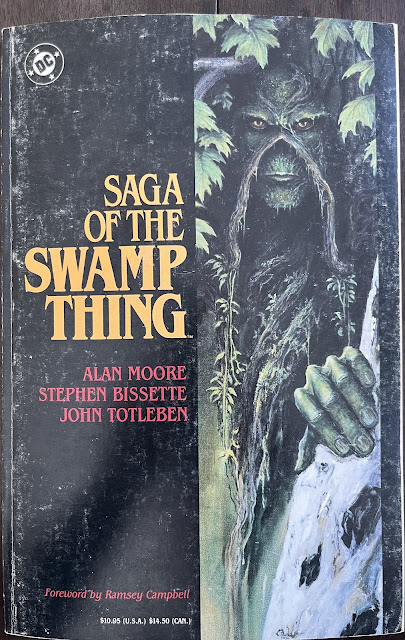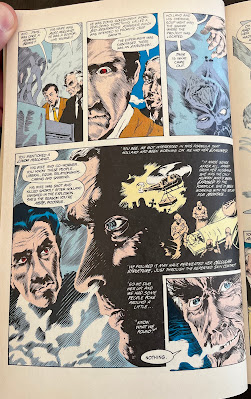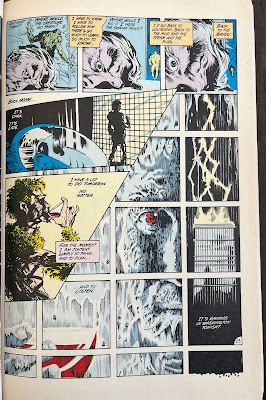Saga of the Swamp Thing #21: "The Anatomy Lesson"
This is the big one! The book that changed it all -- for Swampy in particular but also for western comics.
We open with Moore’s purple prose — “It’s raining in Washington tonight. Plump, warm summer rain that covers the sidewalks with leopard spots.” With the caveat of art being subjective, this is one of Moore’s many strengths, to my mind. His words are poetic and smooth. Unlike some comic writers whose attempts at poetic captions become overbearing and can put a halt to the flow of the issue, Moore’s words carry readers along beautifully, adding to the depth of the reading experience.
With this opening page, Moore and his collaborators give readers the end of this particular issue’s story before we’ve even had the beginning. This technique predates one Moore (as well as other creators) will use in later works. One example being Moore & Dave Gibbons utilizing it to great effect in issue #9 of Watchmen.
The title of “The Anatomy Lesson” in a body formed by separate sections is a nice tip of the cap to graphic designer Saul Bass, known primarily for his movie posters and title sequences for films. This image directly homages his design work for Anatomy of a Murder.
On page 2, Moore, Bissette, Totleben, et al. are heavily foreshadowing the climax of this issue, as Jason Woodrue recounts, with disdain, how proud General Sunderland was of his office building, controlled electronically from a central computer system, thus allowing for a limited need for security and other personnel. It is the General’s hubris, epitomized by this pride in his technologically superior toys, that will be his downfall, directly linked with this central computer system.
On page 4, Moore et al. drop the first hint of the major revelation coming later in this issue — the fact that Linda Holland, Alec Holland’s (Swamp Thing’s) wife, who was similarly permeated by the bio-restorative formula that was supposed to have caused Alec to become the Swamp Thing, has no indication of the reanimation her husband experienced. If both were exposed to this formula, but Alec is the only one revived after the explosion, then what is the anomaly that caused that? Why was his fate different from hers? This foreshadowing is accentuated by Sunderland’s admission that the fact she did not survive is not unusual, since “the formula wasn’t designed to affect human tissue.”
As Woodrue works through his autopsy of Swamp Thing, the idea that something odd has happened and some revelation about the swamp monster’s origin is impending becomes more evident as he discusses the organs exhumed from the corpse. They look like human organs, but they are made of plant fibers, they cannot work in the same manner — and do not work in the same manner — as those organs would in a human body. The lungs, the brain, the heart — all useless.
Foreshadowing.
Page 8 — we get more foreshadowing for the end of this issue, as Woodrue recounts his meetings with Sunderland while he worked through the autopsy. Woodrue describes how Sunderland would “stroll proudly around that huge and empty tomb of a building.” The word ‘tomb’ is purposeful, hinting at how this will end up being the resting place for Sunderland, in the end.
Page 9 — Moore et al. give us a metaphorical analogy of Woodrue’s revelation as to what the Swamp Thing is and how he lives, through words (“It was as if the clouds were suddenly blown away.”) and imagery (Woodrue having entered his shower with his faux human skin and the rush of water from the shower head washing away that skin to reveal the Floronic Man beneath, just as the confusion surrounding the Swamp Thing was swept, or blown, away by his intuitive leap).
Pages 11-12 — This explanation of how Alec Holland became Swamp Thing — that Holland was already dead when his remains fell into the swamp, that microorganisms coupled with the bio-restorative formula acted like planarian worms or cannibals and ate his remains allowing his intelligence to pass to them, and that these microorganisms reconstituted a body as it remembered it, in order to appease the intelligence seething through them, that “it was a plant that thought it was Alec Holland” not Alec Holland turned into a plant, which has been the status quo since the beginning — was mind-blowing at the time and still is. It’s a reinvention of the Swamp Thing that does not invalidate anything that came before, but allows for a new idea and new stories to follow that are more thought-provoking than anything that could have been created previously.
It also augurs the reconstitution of Jon Osterman’s body into Dr. Manhattan in Watchmen. It’s almost as if Moore were testing out the ideas that would encompass his magnum opus, just a few years later.
Page 13 — And with Woodrue’s explanation of what the Swamp Thing is, Sunderland cuts off Woodrue before the scientist can offer the ultimate understanding of the entire situation, and Sunderland’s fate, thanks to his hubris, is sealed. Because if he’d allowed Woodrue to continue, he would have learned that you cannot kill a plant with a bullet, meaning Swamp Thing was not dead, just dormant, and that if he awakes and discovers the truth, Swamp Thing may find himself unhappy with Sunderland.
Sunderland also goes on about how being rich insulates him from the need to be intelligent (his shrewdness, to his mind, is enough). Sunderland does not feel he needs to “understand how [his] computer works to know that if [he] push[es] that little button, all the … doors open and close.” Except, as we will find out, if he does not understand how the computer works but the scientist in front of him, whom he is belittling and firing, does, then that computer can be turned against its master, as noted by Woodrue on the following page as we see his fingers play over the computer keyboard while reminiscing about how Sunderland “… left [him] alone with his computer…and [he, Woodrue] understood exactly how it worked.”
In retrospect, it was also purposeful that Sunderland described the computer he used to control the entire building as “no bigger than a checkerboard,” on page 2, reiterated by Woodrue in his derisive recounting of what must have occurred after he left, when he states that Sunderland will punch the buttons “to switch the door mechanisms to manual, so that he can control them while he’s away from his checkerboard.” The intimation of Sunderland playing checkers, a kid’s game, while Woodrue is playing chess, a game played by intellects, plays into the difference between these two and also accentuates the fallible confidence suffusing Sunderland.
Page 21 — The image of red, as in blood, returns when Sunderland puts his hand to the panel that should allow him to open the doors. That panel turns red, indicating it cannot be unlocked, that there is ‘no exit.’ This is followed by a panel mirroring those on page 1, where we saw Sunderland on the other side of the window before the image became permeated with red, with his blood.
Sunderland is about to die.
Page 23 — The final words of the issue, “It’s raining in Washington tonight,” are a reiteration of the first words, a mirror of the opening.
The imagery, particularly the panel layout, is also mirrored here. On the first page, the first few panels are roughly trapezoidal, with edges parallel to the page border on the left and angled edges to the right. This is duplicated on the final page as well. Also on page one, we started with Woodrue staring out the window of his apartment, sipping wine, then shifted to the images of Sunderland pounding on the glass of one of the windows in his building as he dies, while on page 23, we start with the death of Sunderland and switch back to Woodrue, standing at the window, sipping wine.
This mirroring of panels, and scenes within the panels, will be utilized again by Moore & Gibbons on issue 5 of Watchmen, where the entire layout of that issue is a mirror image, shifting on the center two-page spread of the comic.
Stay tuned next time, to see what this new revelation will mean for Swamp Thing, and for his companions. It’s a helluva ride.
chris
















No comments:
Post a Comment